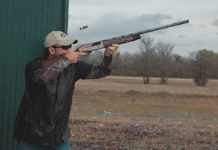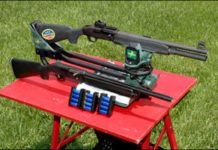In our May 2015 evaluation of 28-gauge shotguns, we focused on a pair of gas-operated semi-automatics and found both the Legacy Sports Pointer and the Beretta Excel shotgun had a lot to offer. Our intention was to follow up with two or three more gas-op 28-gauge autoloaders, but we ran into a problem. The actual number of 28-gauge shotguns of any description currently being produced is relatively small. So for anyone looking to buy a 28-gauge shotgun, they will need to widen their search and consider not just the gas-operated semi-automatics, but also recoil-operated semi-autos and over-under shotguns as well. That is just what we did when setting up shotguns for this test.
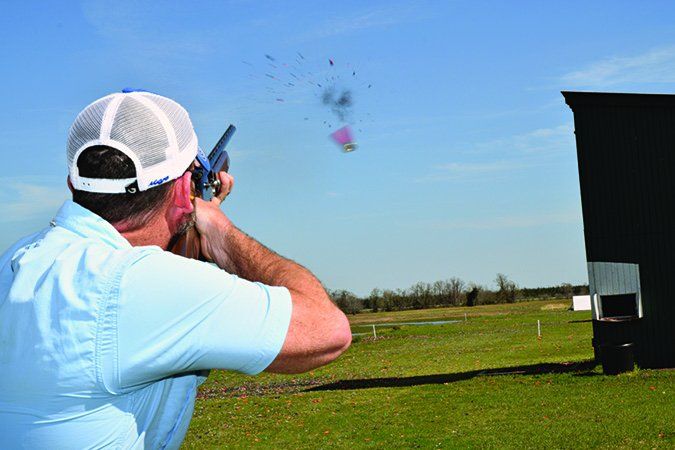
Our representative gas-operated shotgun was the Turkish-made $899 Weatherby SA-08 Deluxe. The Weatherby was actually scheduled for our 2015 evaluation, but a manufacturer’s recall prevented us from acquiring one. The Weatherby in this year’s test was an updated post-recall shotgun.
Next, Benelli is famous for its recoil-operated semi-automatic shotguns, but the company has adopted a term they feel is a more-accurate description — inertia driven, which may indeed offer a more suitable description of how it operates. That is the action in the $2039 Benelli Legacy tested here, one of the more refined semi-automatic shotguns available today.
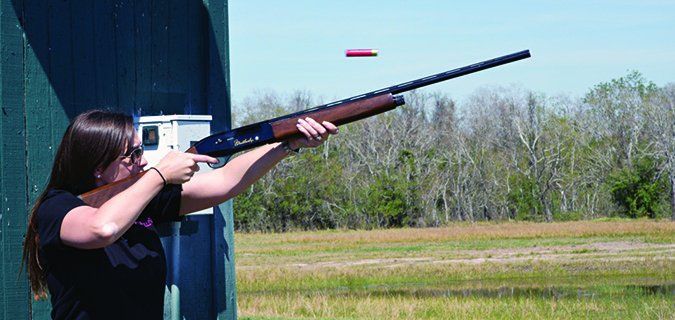
To round out the crew, we chose the $1,699 Franchi Instinct L, an over/under shotgun that is still light, despite having two barrels. Both the Benelli and the Franchi were made in Italy, and, not surprisingly, they are both owned by Beretta.
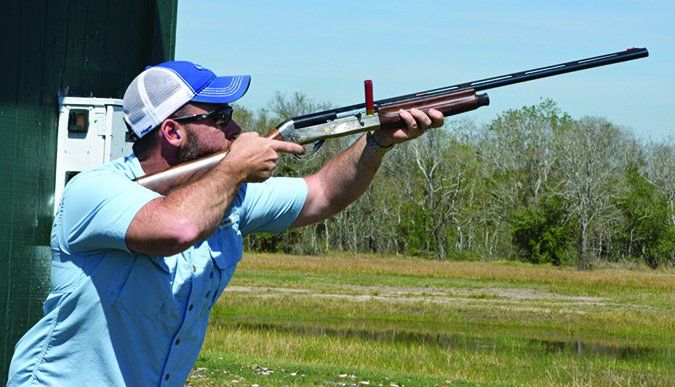
Our testing procedure began with patterning each shotgun from a distance of 25 yards with a Modified choke installed. Since the Franchi had two barrels and order of fire was interchangeable upon command, we patterned each barrel as though it were two different shotguns, changing to the Modified choke for each pattern. Three shots were fired on the target to give us a true reading of pattern spread and point of impact.
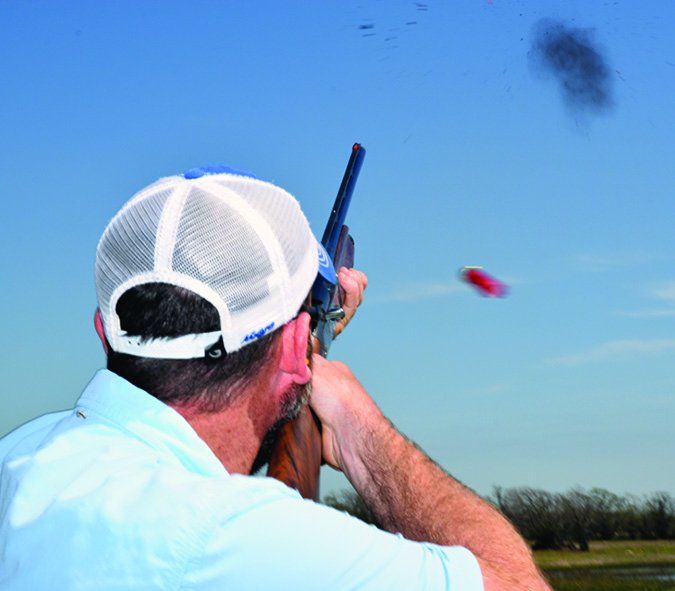
All three guns accepted 2-inch shells, and our three test loads were each rated at 1200 fps carrying ounce shot charges. The Estate Super Sport Competition Target load held No. 7 shot. Our Fiocchi 28GT8 load delivered No. 8s, and the Winchester ammunition was loaded with No. 9s.
The second phase of our tests was more fun than patterning, beginning at the self-pull stations at American Shooting Centers in Houston. From there we moved to ASC’s skeet ranges. Here’s what we learned about the shotguns on the range:
Weatherby 28 Gauge SA-08 Deluxe, $899
GUN TESTS GRADE: A

Sub-gauge recoil with big-gun balance and feel makes this a great all-round shotgun.
| ACTION TYPE | Semi-auto, gas operated |
| CHAMBER SIZE | 2.75 in. |
| OVERALL LENGTH | 48.75 in. |
| CAPACITY | 5+1 |
| WEIGHT UNLOADED | 5.5 lbs. |
| BARREL | 28 in., blued steel, chrome lined |
| RECEIVER | Blued steel |
| CHOKE TUBES | IC, M, F |
| STOCK | High-gloss walnut |
| BUTTSTOCK LENGTH OF PULL | 14 in. |
| BUTTSTOCK DROP AT COMB | 1.5 in. |
| BUTTSTOCK DROP AT HEEL | 2.25 in. |
| FOREARM | High-gloss walnut |
| FRONT BEAD | Brass |
| REAR BEAD | None |
| RIB WIDTH | 0.25 in. |
| TRIGGER | 5.8 lbs. |
| WARRANTY | N/A |
| TELEPHONE | (805) 227-2600 |
| WEBSITE | Weatherby.com |
| MADE IN | Turkey |
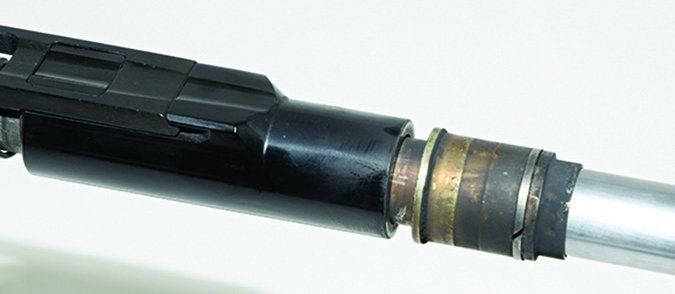
At first glance, it can be difficult to gauge what the Weatherby SA-08’s chambering is. Only an inch or two longer than our other two shotguns, its appearance was much closer to that of a full-size 12-gauge shotgun. We’re not sure what caused that.
Obviously, some care was taken in the selection of the wood. The pistol grip and the forend were machine checkered, probably by pressure but in a classic pattern. The bolt and bolt-release button were chromed. The trigger was stainless steel, and the trigger guard was polymer with a crossbolt safety at the rear, where it joined the receiver.
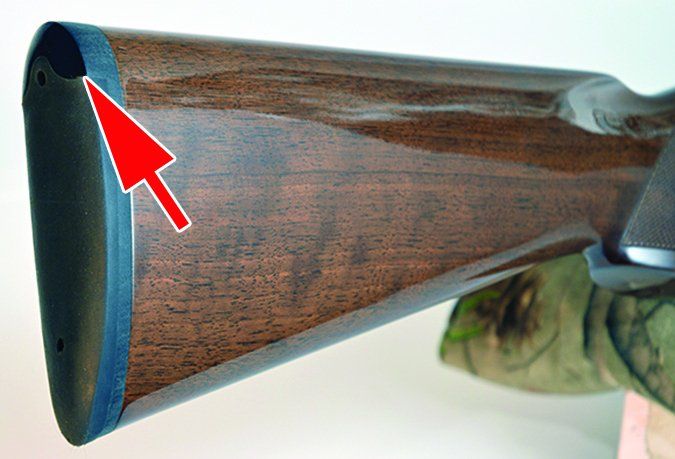
The barrel sported a 1⁄4-inch-wide ventilated rib with only a front brass bead as a sight. The gun arrived with three flush-fit chokes (Improved Cylinder, Modified, and Full) plus one of five different polymer shim plates installed that left the stock cast slightly off to the right. Changing shims required a Phillips-head screwdriver to remove the buttpad, which consisted of a 0.4-inch-thick medium-soft rubber with a smooth plate at the heel, then a 13mm socket wrench to remove the stock. Weatherby recommends that at least one plate be in place at all times.
Weighing in at about 5.5 pounds, the gun seemed a little light for its size. The long barrel made it feel whippy at first, but each shooter in our test team found it easy to adjust his or her swinging motion after just a couple of rounds of skeet.
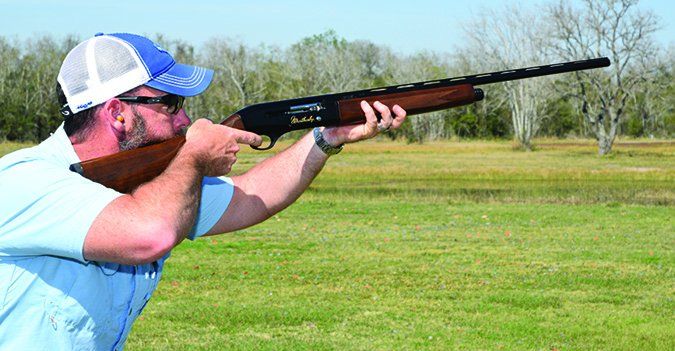
The Weatherby offered the highest capacity. With a full complement of six rounds loaded, the gun’s handling slowed considerably. But even when loaded with only two rounds for the skeet field, the Weatherby transferred the least amount of felt recoil of our three shotguns. We did have one failure to feed after about 200 rounds of fire without lubrication. A spray of RemOil and about 300 rounds later, the Weatherby had not been cleaned and no sign of any malfunctions reappeared.
Patterning the Weatherby SA-08 showed a very similar performance to the Benelli, but with a few more fliers when loaded with the Estate Super Sport Competition Target load. Maybe the manufacturer was not so important in our patterning tests as was the configuration. It is interesting to note that the Weatherby preferred 7 shot, the Benelli No. 8 shot, and the Franchi shotgun No. 9s.
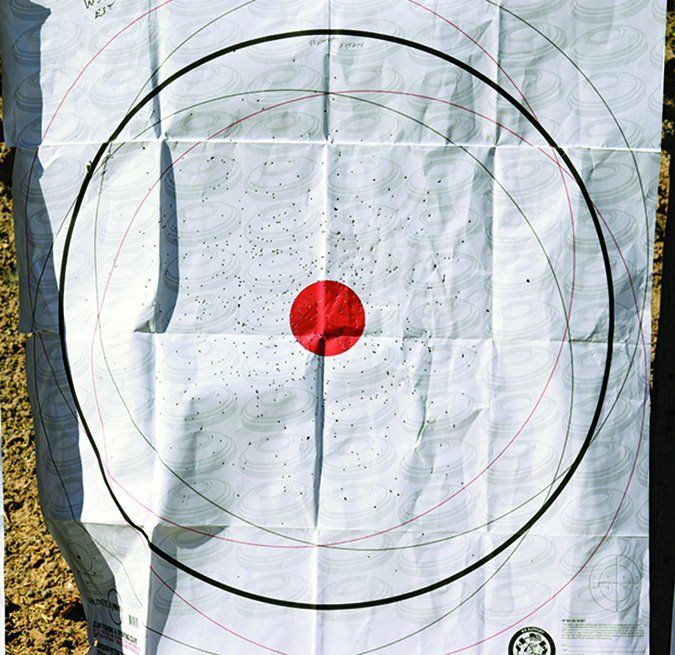
Without changing the original shim setup, we had to work a little harder to center our shots on the pattern board. But with so many shims supplied, we were confident it wouldn’t take much to adapt the drop and cast to just about any shooter.
Our Team Said: This is the shotgun we’d probably choose over many 20-gauge semi-autos for all-round use. The top competitors among our team shooters couldn’t put their finger on any one aspect that was over the top great about it, but by the end of the day, the SA-08 was the gun most of us wanted to continue to shoot. The more we shot it, the more we forgot what gauge it was or how relatively little it cost. More than one shooter agreed they would buy an SA-08 no matter how well the other guns performed.
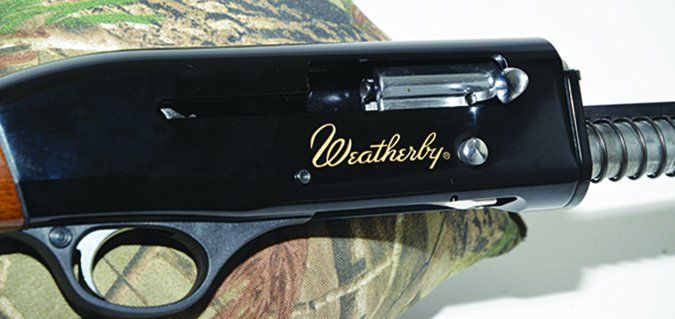
Benelli Legacy 28 Gauge 10435 Semi-Auto, $2039
GUN TESTS GRADE: B+

Looks alone can sell this gun. Fit, pointing, and trigger make for an excellent first shot, but the Legacy’s recoil demands greater effort to maintain control for successful follow-up shots.
| ACTION TYPE | Semi-auto, recoil operated |
| CHAMBER SIZE | 2.75 in. |
| OVERALL LENGTH | 47.5 in. |
| CAPACITY | 2+1 |
| WEIGHT UNLOADED | 5.1 lbs. |
| BARREL LENGTH | 26 in. |
| BARREL | Hammer-forged, Creo-treated |
| RECEIVER | Nickel-plated steel lower, blued steel upper |
| CHOKE TUBES | C, IC, M |
| STOCK | Satin walnut |
| BUTTSTOCK LOP | 14.4 |
| BUTTSTOCK DROP AT COMB | 1.5 in. |
| BUTTSTOCK DROP AT HEEL | 2.25 in. |
| FOREARM | Walnut |
| FRONT BEAD | Filament |
| REAR BEAD | Brass |
| RIB WIDTH | 0.275 in. |
| TRIGGER | 6.3 lbs. |
| WARRANTY | 10 years |
| TELEPHONE | (800) 264-4962 |
| WEBSITE | BenelliUSA.com |
| MADE IN | Italy |
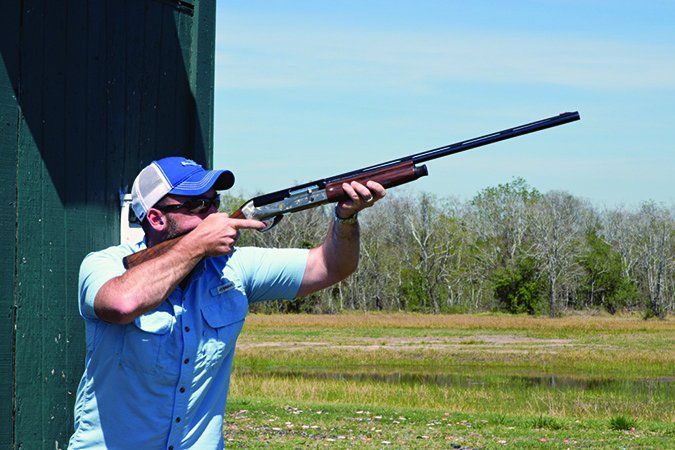
For a lot of people, the Benelli Legacy may end up being the most expensive shotgun in their gun safe. Even if you paid more for another shotgun, the Legacy will likely remain a very special gun. The chrome coating on the bolt and bolt handle was as deep and rich as will be found. The lower portion of the nickel plate steel receiver was etched with scrollwork and two different landscapes below a pair of pheasants on each side. A gold shield amid elaborate leaf and scroll, with the number “28” engraved, adorns both sides as well. The pistol grip wore a badge proclaiming it was a 28 (gauge) on its butt.
The upper part of the receiver was a heavy matte blue and was actually a separate piece entirely. Two-piece receivers are not that common, so the first time you assemble one, its bound to feel a little clumsy. The answer was to fit the upper part of the receiver on to the chamber end of the barrel and going forward, treat the barrel and upper as a single piece.
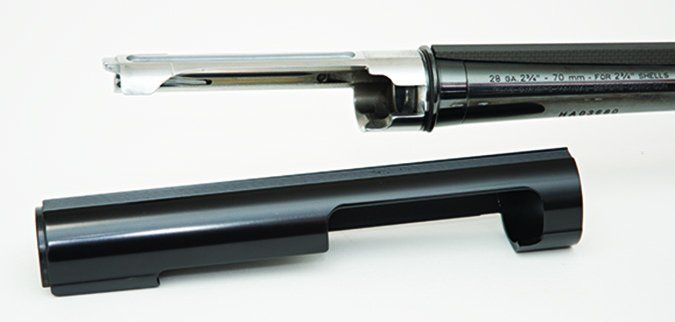
Unlike break-action shotguns, semi-automatics are not regularly disassembled except for cleaning. However, without gas flow to cycle the gun, the Inertia Driven action never seems to need cleaning. This includes the trigger assembly that can be removed by driving out a single pin from the receiver. As a result, you’ll probably want a full-length soft case to go with the hard plastic takedown case that the Legacy arrives in.
The Legacy’s buttpad was moderately thin but pliant, without being sticky. The wood fore and aft was very pleasing but not spectacular. Benelli lists the 20-gauge and 12-gauge Legacy shotguns as having AA-Grade Satin Walnut stocks. Both the 24-inch and our 26-inch-long barreled 28-gauge models ship with Satin Walnut stocks with WeatherCoat. Perhaps the maker fully expects the 28s to spend more time upland than in the safe, but we wondered why the less expensive guns were fit with a higher-grade wood. Checking with BenelliUSA customer service, we learned that the 28-gauge models cost about $240 more due to lower production volume rather than an upgrade in wood.
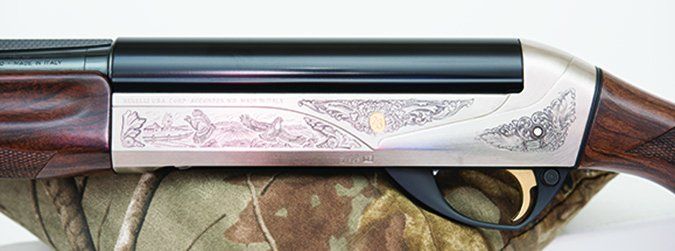
The trigger guard was machined from polymer stock with the sides beveled to guide the finger even when wearing a glove. A crossbolt safety was found at the high rear corner. The trigger was gold plated to match the gold medallion on the receiver. To the right-hand side on the forward edge of the trigger guard was a bolt-lock lever that served three purposes. Not only did it lock open the bolt on an empty chamber but also served to release a shell from the magazine. The appearance of the drop-down lever also served to indicate the hammer was cocked.
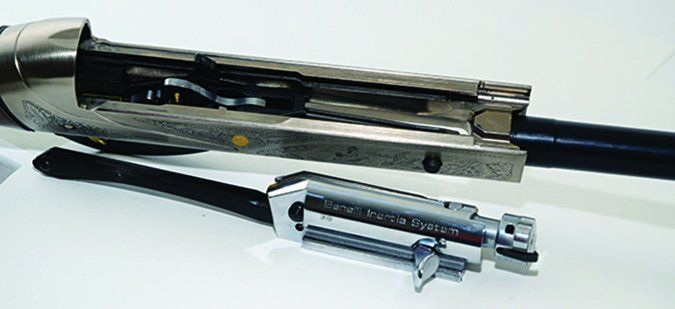
With no need to incorporate a gas system, the forend was dedicated to accommodating the shooter’s support hand. The lower side was checkered, but the most effective feature was its hourglass shape.
The barrel was topped with a ventilated rib with carbon-fiber finish along the sides. There was a stainless steel mid bead directly above the end of the fore grip and a red, light-gathering filament up front. The mount for the filament was removable, held in place by a small slotted screw.
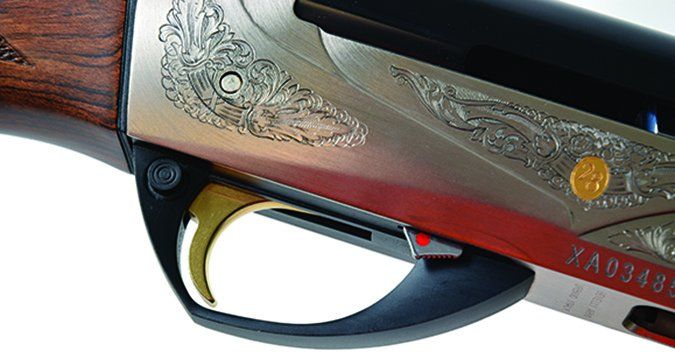
The Benelli Legacy arrived with three chrome-plated flush-fit chokes in Cylinder, Improved Cylinder, and Modified constrictions. Cast off to the right upon delivery, three additional shims were provided with the stock. The shims were steel and easily replaced to modify cast and drop. On synthetic-stock Benelli shotguns, removing the butt pad to gain access to the stock retaining nut is achieved by simply pulling free the buttpad. The buttpad on the Legacy and other wood-stocked Benellis are held in place by a screw top and bottom.
The pattern board showed that our Benelli Legacy favored the Fiocchi number 8 shot ammunition. The pattern was perhaps the most even of all three shotguns, if not as dense as our Franchi, with shot spreading into a nice, wide circle. Despite the gun not being specifically fit to any one test-shooter upon arrival, we found it easy to center our shots on the pattern target.
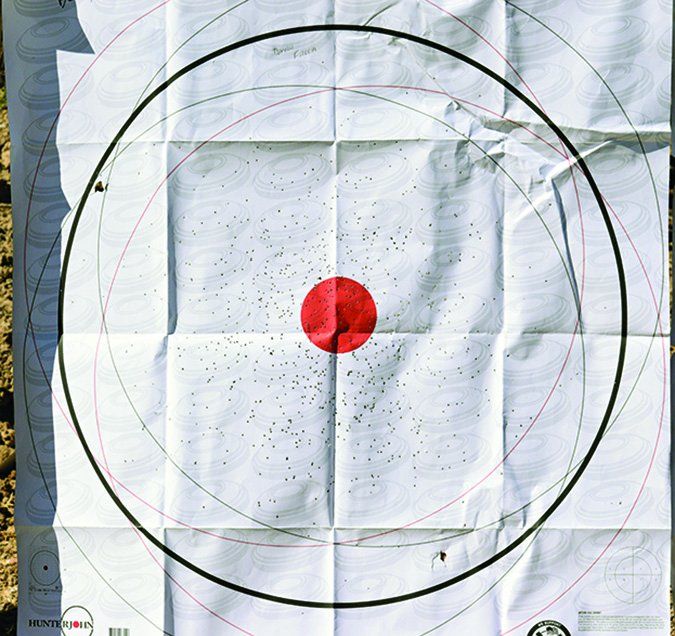
Our Team Said: At first glance this was the gun everyone wanted. Absolutely the best rib, bead, grip, finish and style. But after firing the Legacy our team was broken down to three different camps. For one group the Legacy’s recoil made it uncomfortable to shoot, much more than was expected from a sub-gauge shotgun, and this disqualified it from their choice. The second camp found the level of recoil was far outweighed by its precision fit and accuracy. But they were also skeptical of being able to reset quickly enough to break a second bird. Finally, competitors and hunters who typically shoot a lot of 12 gauge thought the recoil was greater than they expected but nevertheless reveled in its style and accuracy.
Franchi Instinct L 28 Gauge No. 40811 Over/Under, $1,699
GUN TESTS GRADE: A-

The Franchi Instinct is a reasonably priced introduction to the world of serious shotguns. Our team agreed they wouldn’t mind spending additional money to have it professionally fit.
| ACTION TYPE | Over/under w/ barrel select |
| CHAMBER SIZE | 2.75 in. |
| OVERALL LENGTH | 45.5 in. |
| CAPACITY | 2 |
| WEIGHT UNLOADED | 6 lbs. |
| BARREL | 28 in., blued steel |
| RECEIVER | Case-hardened steel |
| CHOKE TUBES | IC, M, F |
| STOCK | Satin walnut |
| BUTTSTOCK LENGTH OF PULL | 14.25 in. |
| BUTTSTOCK DROP AT COMB | 1.5 in. |
| BUTTSTOCK DROP AT HEEL | 2 in. |
| FOREARM | Walnut |
| FRONT BEAD | Filament |
| REAR BEAD | None |
| RIB WIDTH | 0.25 in. |
| TRIGGER | 4.85 lbs. |
| WARRANTY | 7 years limited |
| TELEPHONE | (800) 264-4962 |
| WEBSITE | FranchiUSA.com |
| MADE IN | Italy |
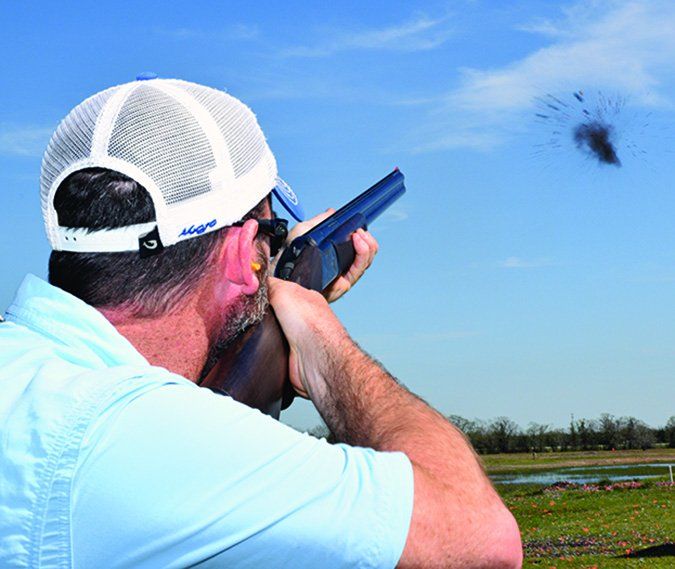
Despite ammunition not being cycled into position before and after each shot, you might be surprised to read that a single-trigger over-under shotgun is often referred to as having a semi-automatic trigger. Once the trigger was pressed and the firing pin behind one chamber has done its job, the trigger resets and is ready to launch the firing pin assigned to the opposite barrel. One pull, one bang, as semi-autos are usually described.
Other features on the Franchi Instinct L were automatic. Such as ejection of the shells when the break action was fully opened and resetting the safety to the on-safe position when the action was closed. Once loaded, the tang-mounted thumb safety must be pushed forward before the gun will fire. The order of fire, meaning which firing pin the trigger releases first, was also under the shooter’s thumb and could be switched at will.
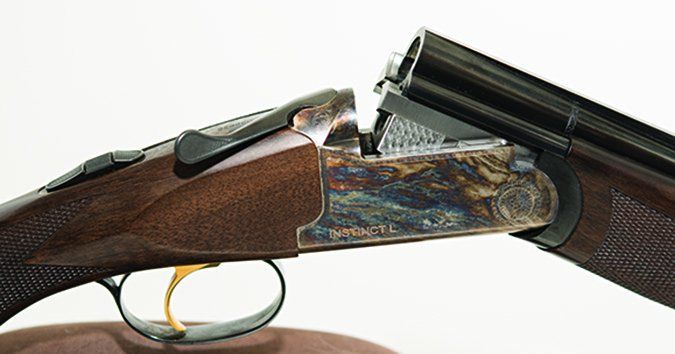
Many competitive shooters prefer to disengage the auto safety, but shooting at the skeet, sporting clays, or trap field means not loading until you are in position and it is your turn to shoot. In the field walking with dogs or other hunters, you might lose a bird by forgetting to turn off the safety, but there will just as likely be a time when the auto safety will prevent a dangerous shot. Whenever we forgot to turn off the safety, we simply dismounted the gun and started our routine over again.
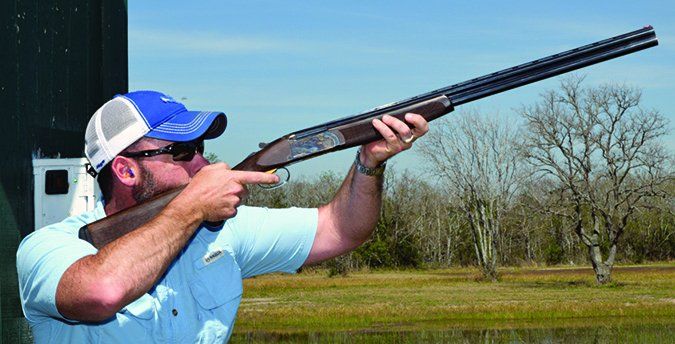
Safety manipulation and a stiff opening lock (which of course eases with time) were the only complaints. The two-stage foam buttpad was almost 1-inch thick. Its application was tight, but the edge of the A-grade satin walnut buttstock looked a little bit chopped. What we really liked about the stock and forend was the checkering. If the Franchi’s checkering was not hand cut, we’d like to have one of their machines because it was well done. Aiding in our strong-hand grip was the Prince-of-Wales stock. Besides looking great, we liked getting our hand low and deep behind the steel trigger guard to work the roomy gold-colored trigger. Aside from available gauges, the Prince-of-Wales stock and tapered Schnabel forend are some of the features that differentiate the Instinct L from the Instinct Sporting.
The receiver of the Instinct L was color case-hardened for greater strength as well as for appearances. The metal work showed modest engraving and had a pleasing hand-drawn look about it. The locking lever was finely checkered. Once open, the lugs were jeweled. We noticed the ejectors in the catalog picture were jeweled as well, but the ejectors on our shotgun were plain.
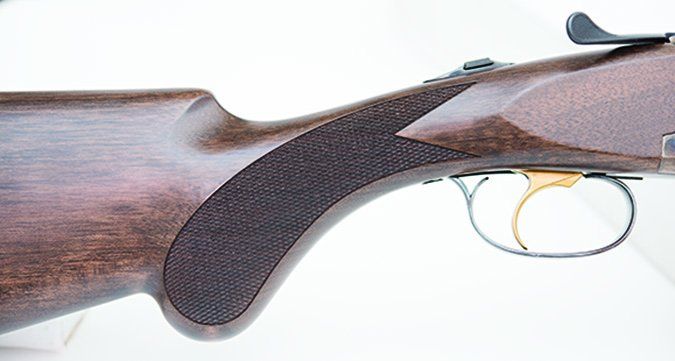
The barrels were joined without ventilation. The top rib was ventilated, but just narrowly, and showed only about a 0.5-inch-long red filament bead. Supplied chokes were chrome-plated flush-fit Cylinder, Improved Cylinder, and Modified. In the field, the progression to a second shot of greater constriction is generally preferred, working on the assumption that once missed, the bird flies farther away. The tighter choke keeps the pattern of shot together longer, enabling it to hit a more distant target. Extended choke tubes including Skeet 1 and Skeet 2 are optional.
At the patterning board, we decided to compare the top barrel to the bottom barrel by sharing the modified choke between the two. What we found was the top barrel seemed to produce fewer fliers than the bottom barrel. Actually, the top barrel of the Instinct L was the top performer overall when firing the Winchester No. 9s, producing the densest pattern and fewest flyers. Aiming with the bead to same spot on the target as when firing the upper barrel, the pattern printed slightly lower, as would be expected. The lower barrel printed more flyers, but the pattern was otherwise close to being identical to the pattern from the upper barrel.
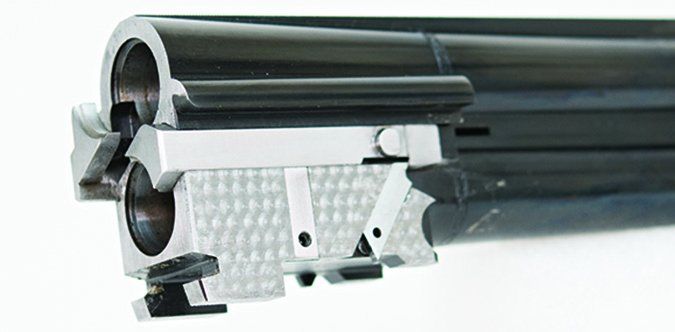
The Instinct L seemed to recoil less when fired from the lower barrel, helpful to what is a popular practice, firing from bottom to top. Certainly the impulse to move the barrel upward was less than when firing the top barrel. In terms of actual patterns, all three loads produced dense patterns. The Estate 7 rounds finished second, producing a few more flyers. The Fiocchi number 8s seemed to string vertically, with errant hits top and bottom.
Our Team Said: The upland hunters and the skeet competitors on our team were split on their view of the auto safety. Not everyone liked the work it took to open a new O/U shotgun, but they understood it would become easier with use, and it did indeed after about 200 rounds. The Instinct L was rated second in most recoil among our three shotguns. What was really surprising was that in spite of every complaint, the Instinct L was the one shotgun that each member of our team agreed they would spend additional money on to have it professionally fit. At the end of the day, we thought that with proper fit and additional practice, our scores would show the most significant improvement with this gun rather than continuing to shoot with either of the semi-autos. As one shooter put it, he’d choose the Instinct L as his first serious over-under.
Written and photographed by Roger Eckstine, using evaluations from Gun Tests team testers.

























